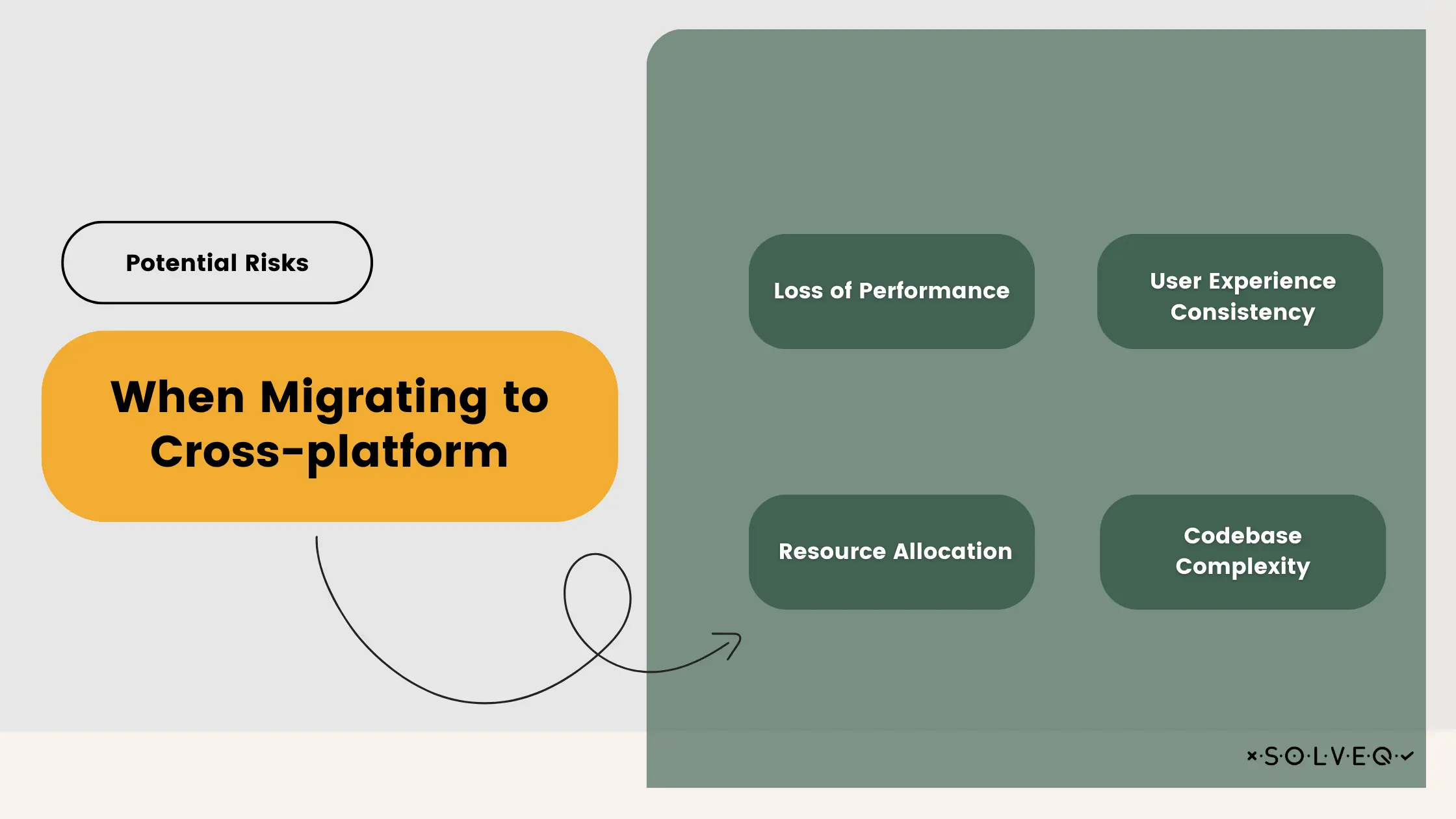Why migrate native apps to cross-platform technologies?
30 Jan 2024 • 13 min read

Marcin Kulawik

In the realm of mobile app development, native and cross-platform approaches represent two distinct paths. While native apps have excelled in performance, cross-platform solutions are rapidly gaining popularity due to their efficiency and broader reach. This article explores the shift from native to cross-platform app development, highlighting why this transition is becoming a strategic choice for many in the industry. We will delve into the advantages, the migration process, and key considerations of adopting cross-platform technology.
Understanding Native and Cross-Platform Technologies
Native apps are tailored specifically for individual platforms, such as iOS or Android, utilizing languages like Swift or Kotlin. These applications offer superior performance and a seamless user experience, fully harnessing the device's capabilities. Their main limitations, however, are the higher costs and longer development times, as they require distinct codebases for each platform.
In contrast, cross-platform apps are built using a unified codebase that works across multiple operating systems. They leverage frameworks such as:
- React Native: Utilizes JavaScript and React.
- Flutter: Google's UI toolkit using Dart.
- Xamarin: Employs C# and .NET.
These technologies streamline the development process and reduce costs by enabling code reuse. The trade-off, however, is that they might not deliver the same level of performance or integration with device-specific features as native apps.
Comparative Analysis
The comparison between native and cross-platform apps centers on several key aspects:
- Development Efficiency: Cross-platform apps lead in efficiency due to their single codebase.
- Performance: Native apps generally offer better performance and a more intuitive user experience.
- Cost Implications: Native apps are more resource-intensive, especially when targeting multiple platforms.
The decision to choose between native and cross-platform development hinges on factors such as the project's specific requirements, target audience, desired features, and available budget and time.
Business Value of Migrating to Cross-Platform
The migration to cross-platform development is not just a technical decision but a strategic business move. It offers tangible benefits in terms of operational efficiency and market competitiveness, which can be seen through several key aspects:
Cost-Effectiveness
Utilizing a single codebase for both iOS and Android platforms significantly reduces development and maintenance costs. This approach minimizes the initial financial outlay and simplifies ongoing updates, making it a more economical choice for businesses.

Market Reach
Cross-platform apps allow businesses to easily target a wide range of users across iOS, Android, and sometimes web platforms. This increased accessibility is essential in today's varied mobile market, enabling broader user engagement without the need for extra resources.
Maintenance and Updates
The streamlined process of updating one unified codebase, as opposed to multiple native ones, simplifies maintenance. This efficiency ensures a consistent and up-to-date app experience across all platforms, saving time and resources.
Speed of Development
Cross-platform technologies accelerate development cycles, allowing businesses to respond rapidly to market changes or user feedback. This agility is crucial for staying competitive in the fast-evolving digital landscape.
Case Studies
- Airbnb: Their adoption of React Native facilitated faster development while maintaining a high-quality user experience on both iOS and Android. This showcases the effectiveness of cross-platform development in balancing quality with efficiency.
- Uber: By leveraging cross-platform technologies, Uber has been able to quickly roll out updates and new features, ensuring a reliable service globally. Their experience highlights the scalability and agility of cross-platform solutions.
In essence, the shift to cross-platform development represents a strategic decision that brings cost savings, expanded market reach, ease of maintenance, and faster development, all contributing to a strong business proposition in the digital era.
Technological Advantages of Cross-Platform Development
Cross-platform development offers significant technological advantages, stemming from the unique characteristics of cross-platform frameworks.

Shared Codebase
The shared codebase in cross-platform development allows code to be written once and deployed across multiple platforms. This reduces development time and effort, simplifies bug tracking and feature updates, and ensures consistency across different devices.
Performance
Modern cross-platform frameworks like Flutter and React Native have significantly narrowed the performance gap with native apps. They optimize performance and closely mimic native app behavior, offering adequate performance for most use cases.
Access to Native Features
Modern frameworks have bridged the gap in accessing native device features. Technologies like React Native and Xamarin allow cross-platform apps to access native functionalities like camera, GPS, and sensors, closely paralleling the experiences offered by native apps.
Community and Support
The strength of cross-platform frameworks is also evident in their community and support:
- Large Developer Communities: Frameworks like Flutter and React Native have vast, active developer communities.
- Rich Ecosystem: These communities contribute to a rich ecosystem of plugins, tools, and libraries.
- Continuous Improvement and Innovation: Community-driven development fosters continuous innovation.
- Extensive Resources: A wealth of resources for troubleshooting, learning, and development support.
These technological advantages, including a unified codebase, competitive performance, native feature access, and robust community support, underscore the growing appeal of cross-platform solutions in the app development realm.
Overview of the Migration Process
Migrating to a cross-platform framework is a strategic process that involves several critical steps. Each stage plays a crucial role in ensuring a smooth transition and successful implementation.
Assessment and Planning
The first step in the migration process is a thorough assessment of the current app. This involves:
- Analyzing the existing app's architecture, features, and performance metrics.
- Identifying components that can be reused and those that need redevelopment.
- Planning the migration timeline, considering business objectives and user needs.
- This stage is crucial for understanding the scope of the migration and preparing a detailed roadmap.

Choosing the Right Technology
Selecting the appropriate cross-platform framework is vital and depends on several factors:
- The specific requirements and complexity of the app.
- The desired level of performance and native feature integration.
- The development team’s expertise and the framework’s learning curve.
- Community support and the ecosystem of the chosen technology.
- This decision will significantly influence the development process and the app's capabilities.
Redesign and Development
Migrating to a cross-platform solution often necessitates a redesign and redevelopment of the app
- Redesigning the user interface to ensure consistency across different platforms.
- Redeveloping features to align with the capabilities of the new framework.
- Ensuring the app’s architecture is scalable and maintainable.
- This phase is critical for leveraging the benefits of cross-platform technologies while maintaining or enhancing the user experience.
Testing
Thorough testing is imperative to ensure the app functions seamlessly across all platforms:
- Conducting functional, performance, and usability testing on different devices and OS versions.
- Identifying and fixing platform-specific bugs and inconsistencies.
- Validating the app’s performance against the original native app.
- Testing is essential for ensuring the quality and reliability of the migrated app.
Deployment and Monitoring
The final phase involves deploying the new app and monitoring its performance:
- Implementing best practices for app deployment across different platforms.
- Continuously monitoring the app’s performance and user feedback.
- Being prepared for iterative updates and quick fixes.
- Deployment and monitoring are crucial for maintaining app quality and responding to user needs post-launch.
In summary, the migration to a cross-platform framework is a comprehensive process that requires careful planning, the right technology selection, thoughtful redesign and redevelopment, rigorous testing, and meticulous deployment and monitoring. Each of these steps is essential to ensure the success of the migrated app in meeting business goals and providing value to users.
Challenges and Considerations in Migration to Cross-Platform Development
Migrating to cross-platform development, while beneficial, comes with its own set of challenges and considerations. Addressing these effectively is key to a successful migration.

Potential Risks
The migration process involves several potential risks that need careful consideration:
- Loss of Performance: Migrating from a native platform can sometimes lead to a decrease in app performance, especially for complex applications.
- Resource Allocation: Effective migration requires adequate allocation of time and resources, including skilled development personnel.
- User Experience Consistency: Maintaining a consistent user experience across different platforms can be challenging.
- Codebase Complexity: Integrating different functionalities into a single codebase can lead to increased complexity.
Identifying and planning for these risks early in the migration process is crucial for mitigating potential problems.
Performance Concerns
Performance is often a major concern in the migration to cross-platform development:
- Myth: Cross-platform apps cannot match the performance of native apps.
- Reality: Modern cross-platform frameworks have significantly improved in terms of performance. While there may be differences in highly intensive tasks, for most applications, cross-platform solutions provide more than adequate performance.
Understanding the capabilities and limitations of the chosen framework is essential for managing performance expectations.
Compatibility and Integration Issues
Integrating with existing systems and third-party services presents its own challenges:
- Existing Backend Systems: Ensuring compatibility with existing backend systems is crucial. This might require modifications to the backend to support the new cross-platform app.
- Third-Party Services: Dependency on third-party services or libraries that may not be available or fully functional in a cross-platform environment can pose significant challenges.
- Device-Specific Features: Accessing device-specific features and hardware can be more complex in a cross-platform setting and may require additional development work.
- Proactively addressing these compatibility and integration issues will help in ensuring a smooth migration process.
In conclusion, while the migration to cross-platform development offers numerous advantages, it is important to navigate the potential risks, performance concerns, and compatibility issues carefully. A well-planned approach, considering these challenges and considerations, is essential for a successful transition.
Summary
As the mobile app industry evolves, a significant shift from native to cross-platform development is observed, driven by the promise of cost savings, wider reach, and streamlined development. This article explored the advantages and challenges of this transition, highlighting the shared codebase and improved performance as key benefits. The move to cross-platform development emerges as a strategic decision for businesses seeking efficiency and scalability.
Considering a move to cross-platform app development? Reach out to us for expert guidance and support in your transition journey.
Share:
Looking for expert development team?
Schedule a call with Tech Consultant

Marcin Kulawik
Founder and CEO of SolveQ. Huge fan of building things with purpose, agility, and having fun while changing the World. Loves his family, teammates, and nature.